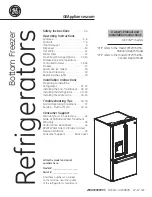
39
818 17 20-02/3
Hints and Tips
GB
Saving energy
·
Pay careful attention to where the cabinet is
placed. See the section "Installation". When
installed correctly, the cabinet will consume less
energy.
·
Try to avoid keeping the door open for long
periods, or opening the door too frequently as
warm air will enter the cabinet, and cause the
compressor to switch on unnecessarily often.
·
Ensure there are no obstructions preventing the
door from closing properly.
·
Thaw frozen food in the fridge. This will ensure
safer defrosting of foods and reduce the work of
the refrigeration unit
·
It is advisable to periodically clean the
refrigeration system at the back of the appliance
with a duster or vacuum cleaner.
·
Always leave warm food to cool down to room
temperature before placing in the fridge.
·
Food which is to be frozen (when cool) should
be placed in the fridge before being transfered to
the freezer.
·
Avoid unnecessary frosting in the cabinet by
packing all foodstuffs into airtight packages
before placing them in the freezer.
·
Carefully follow the advice on freezing products
in the section "Using the freezer". This will
prevent wasting energy.
·
Do not set the temperature too low in the freezer.
A suitable temperature is in the range of -18°C
to -20°C .
·
Defrost the freezer when the frost layer reaches a
thickness of 3-5 mm.
·
Make sure the door gasket is complete and
always clean.
Food Storage
·
To obtain the best results from your appliance,
neither hot foods nor liquids which may
evaporate, should be placed in the larder
compartment.
·
Avoid buying frozen food if you can not store it
straight away. The use of an insulated container is
advisable. When you arrive home place the
frozen food in the freezer immediately.
·
Ensure that food placed in the freezer is dated and
labelled and used in date order to ensure that food
is consumed at its best.
Remove suspect food from you refrigerator and
clean, refer to cleaning and maintenance.
Protect the environment
·
Hand over the cabinet packaging and discarded
fridges and freezers to a recycling station.
Contact your local council or Environmental
Health office for more information.
·
Keep foodstuff in re-usable containers. Cut down
on disposable material as much as possible.
·
When cleaning the cabinet, use a mild
washing-up detergent.
·
Follow the advice in the section "Saving energy"
·
The door gasket and coolant used in this
cabinet will not harm the ozone layer.
·
All parts in the packaging can be recycled.
·
The cabinet has been designed for easy
dismantling and subsequent recycling.
Maintenance and Cleaning
GB
Removing the ventilation grille
The ventilation grille can be removed, e.g. to wash
the grille.
Unsnap the ventilation grille by pulling it toward
you.



































